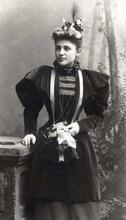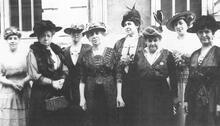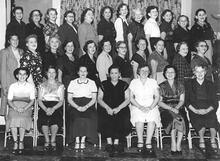Cedar Knolls School for Girls
The Cedar Knolls School for Girls was founded in 1911 as a correctionary facility, in response to what its founders saw as a rise in delinquency among young Jewish women. Those admitted were referred to the school for a variety of reasons, including disorderly conduct, "improper guardianship," and "incorrigibility." The founders, the women of the New York Jewish Protectory and Aid Society, believed that this rise could be attributed to several factors, many stemming from struggles encountered by immigrant families. Cedar Knolls aimed to rehabilitate through education, vocational training, strong religious instruction, and moral guidance. Eventually, Cedar Knolls became co-educational and expanded into psychiatric care. It closed in 2018.
Background
In November 1911, a group of Jewish women convened under the auspices of the New York Jewish Protectory and Aid Society, an organization that had been founded in 1902 to address the problem of Jewish juvenile delinquency. The women, many of whose husbands were associated with the society, resolved to provide “for the care of delinquent girls of our faith.” Among those spearheading this effort were Madeleine Borg, Julia Richman, Florence Lowenstein Marshall, Alice Davis Menken, Sissie Strauss Lehman, Mrs. Arthur Sachs, and Adele Neustadt Schiff.
Alarmed by reports of the growing numbers of young females arraigned in New York City’s children’s courts, the concerned women advocated the establishment of a Jewish girls’ correctional facility comparable to the existing Hawthorne School. This Jewish reformatory for boys had opened in May 1906 in Hawthorne, New York. The school, one of the first such institutions in the country, was built on the “cottage,” or group living, plan and was widely acclaimed for its emphasis on rehabilitation, rather than punishment, in the treatment of troubled youngsters.
Founding Cedar Knolls
Working independently, though in consultation with the Hawthorne School directors, the women founders raised the necessary funds and established the Cedar Knolls School for Girls (CK) in 1913. Financed by private donations and city subsidies, the residential school (originally known as the Council Home for Jewish Girls) operated out of temporary quarters in Bronxville, New York. In August 1917, Cedar Knolls moved to its own building on the Hawthorne campus.
The initial group of seventeen girls admitted to the school was aged twelve to sixteen and were generally referred by the children’s courts, individuals, or organizations. The girls were committed to Cedar Knolls and other institutions for a variety of reasons, including disorderly conduct, peddling, “improper guardianship,” “malicious mischief,” “incorrigibility,” “immorality,” stabbing or assault, and petty larceny. These young women, according to longtime CK president Madeleine Borg, were “not hardened criminals, but only children deprived of their natural heritage and rights.... it was our duty to assist [them].”
Teaching Model
CK directors strove to rehabilitate their students through basic education, vocational training, religious instruction, wholesome recreation, and, most importantly, moral guidance. Girls were required to complete the regular course of study mandated by the New York City Board of Education. They also received instruction in various vocational subjects, including hand and machine sewing, embroidery, knitting, millinery, typing, and, later, hairdressing. The school’s Jewish character was reflected in its Sabbath and holiday services, weekly classes in Hebrew, Bible, and biblical history, and confirmation ceremonies for the girls.
Beyond formal instruction, the girls enjoyed many recreational activities, such as clubs, storytelling, music, gardening, dramatics, instructive talks, weekly campfire gatherings, Girl Scout programs, physical exercise, and dancing. They were also responsible for daily upkeep of the school, and through cleaning, cooking, laundering, and sewing the girls prepared for their future domestic roles.
In all aspects of the program, the emphasis was on cooperation, teamwork, and mutual responsibility. Directors were determined to teach their highly individualized students to function as part of a group.
"The Problem of the Delinquent Jewish Girl"
The CK’s well-to-do women managers strove to govern by kindness and were dedicated to their mission. They clearly saw themselves as benefactors, patrons, and role models for their young charges. Borg commented in 1917, “We have always borne in mind the importance of surrounding these girls with women of refinement and ideals who, both by precept and example, would influence the girls to a loftier viewpoint of life.”
The women involved in this work attributed rising Jewish juvenile delinquency to the difficulties experienced by immigrants as they adjusted to life in the United States. Of the 145 girls enrolled in Cedar Knolls between 1909 and 1921, 109 were foreign-born, while only 36 were American-born. As Borg explained in 1913:
The problem of the delinquent Jewish girl is the most recent issue.... The Jews ... with their strong religious principles and ... high ... ideals as to the chastity of their persons, thrown into new surroundings, where the customs of the country are strange and incomprehensible to them, amid different economic conditions, where the struggle for mere existence is so keen, find many of their cherished beliefs slipping away from them as impossible and impracticable.
In particular, female reformers and philanthropists pointed to the following factors as contributing to Jewish juvenile delinquency: incompatibility between immigrant parents and their American-born children, lack of religious education, overcrowding in immigrant neighborhoods, bleak home environments resulting in girls’ attraction to the excitement of cabarets or dance halls, inadequate vocational training in the schools that reduced young women’s wage-earning capacity, and few parks and playgrounds available for wholesome recreation.
As stated in the 1922 annual report of the Jewish Board of Guardians, CK was designed for delinquent girls who required “more regular and systematic treatment than preventive agencies can give.” However, the women managers were quick to recognize the multidimensional nature of their work. Many branched out into related areas, in addition to their involvement with the school. Some joined or supervised the growing Big Sister movement, one of the most important preventive programs in the treatment of juvenile delinquency. As Big Sisters, they offered guidance to large numbers of young girls referred to them by parents, schools, the courts, charities, and social service agencies. In addition, the managers of CK went on to train volunteers through lecture courses on child psychology and development that were organized by synagogue sisterhoods and settlement houses. Other women connected with CK became involved with the Lakeview Home for Unmarried Mothers, a project of the Jewish Protectory and Aid Society with the cooperation of the National Council of Jewish Women. Moreover, the school’s paid probation officer, as well as women volunteers, represented Jewish girls in New York City’s juvenile courts.
Expansion
By 1930, CK had expanded considerably, housing fifty girls. The length of time spent in the institution varied, depending on each girl’s circumstances and progress. Most were released to their parents or relatives and were able to find suitable employment. Many eventually married and established their own households.
As the population of the combined Hawthorne/Cedar Knolls School gradually changed to include more emotionally disturbed and socially maladjusted youngsters, the institution focused on individualized treatment. In order to meet the needs of these students, the school established its first psychiatric clinic in 1935.
By the late 1980s, the Hawthorne/Cedar Knolls School, now coeducational, served some 170 youngsters, aged eight to twenty-two, both Jewish and non-Jewish. The school remained in existence until 2018, and the treatment program, sponsored by the Jewish Board of Family and Children’s Services, provided troubled boys and girls with a “cottage” group-living experience, clinical counseling services, special education, and recreational activities.
Aim
CK directors took great pride in their achievements on behalf of delinquent girls. As Madeleine Borg (who was also among the founders of the Jewish Board of Guardians, and its president from 1942 to 1951) observed, “Our aim in creating our Home is to give to these girls who have been denied through circumstances the privileges to which every child is entitled, an opportunity to readjust themselves and to return to the community as useful and self-respecting members” (Borg, 1917).
Borg, Madeline. Jewish Protectory and Aid Society. Annual reports, 1911, 1913, 1917; Cedar Knolls School. Archival collection. Jewish Division, New York Public Library.
Jewish Board of Guardians. Annual report, 1922.
Menken, Alice D. Tales of One City—A Few Selected Stories to Illustrate the Rehabilitation of the Morally Handicapped: A Study in Social Services (1924): 24–25.
Morris, Robert, and Michael Freund. Trends and Issues in Jewish Social Welfare in the United States, 1899–1952 (1966)
Rischin, Moses. The Promised City: New York’s Jews, 1870–1914 (1962)












